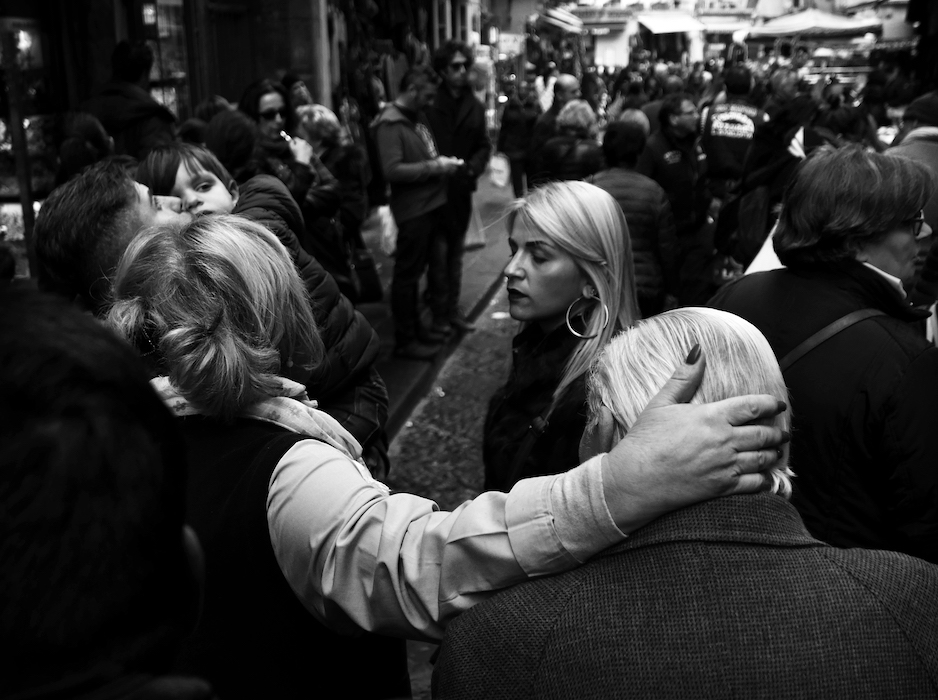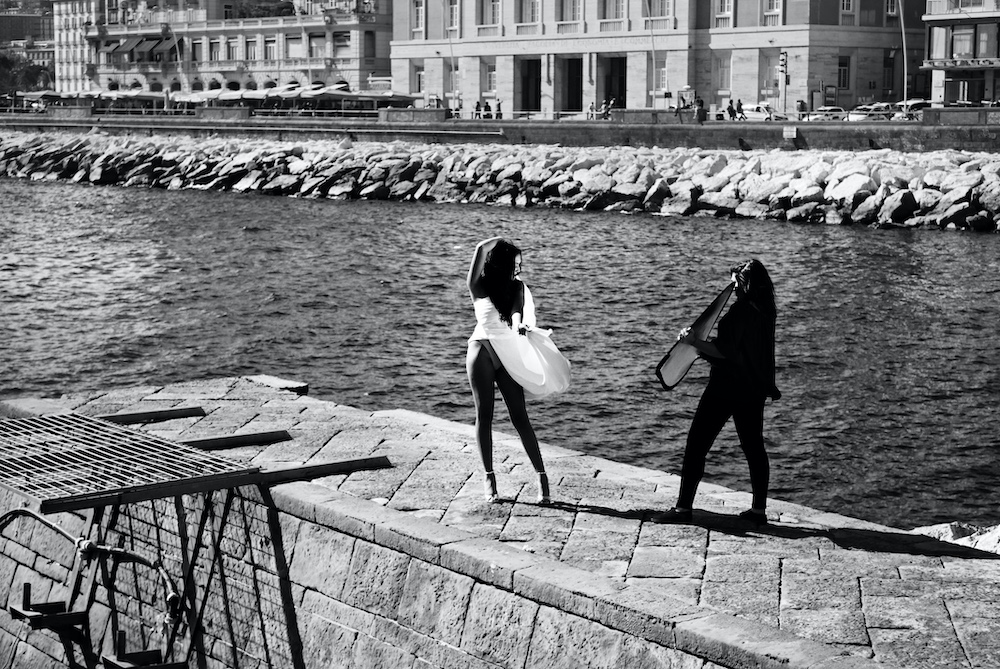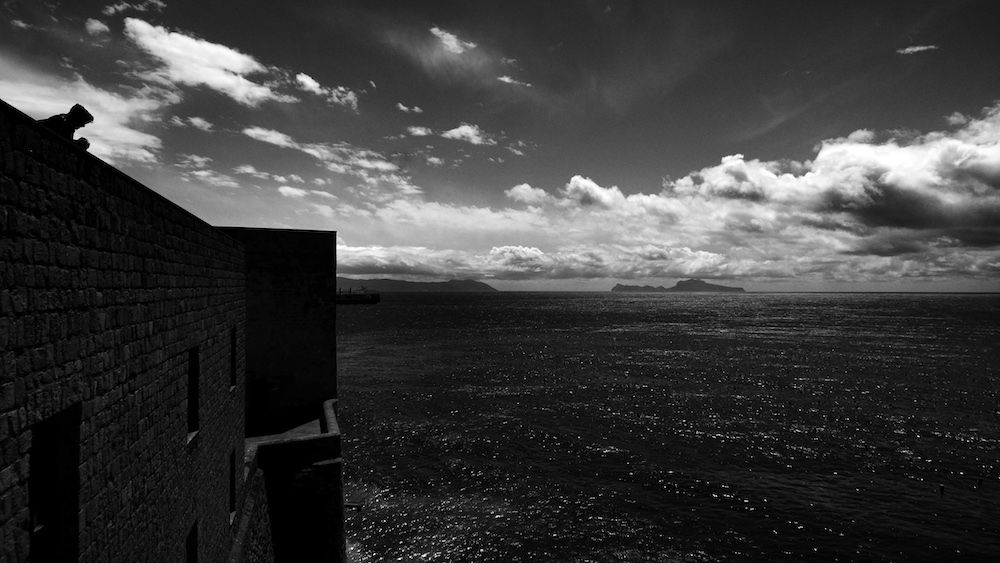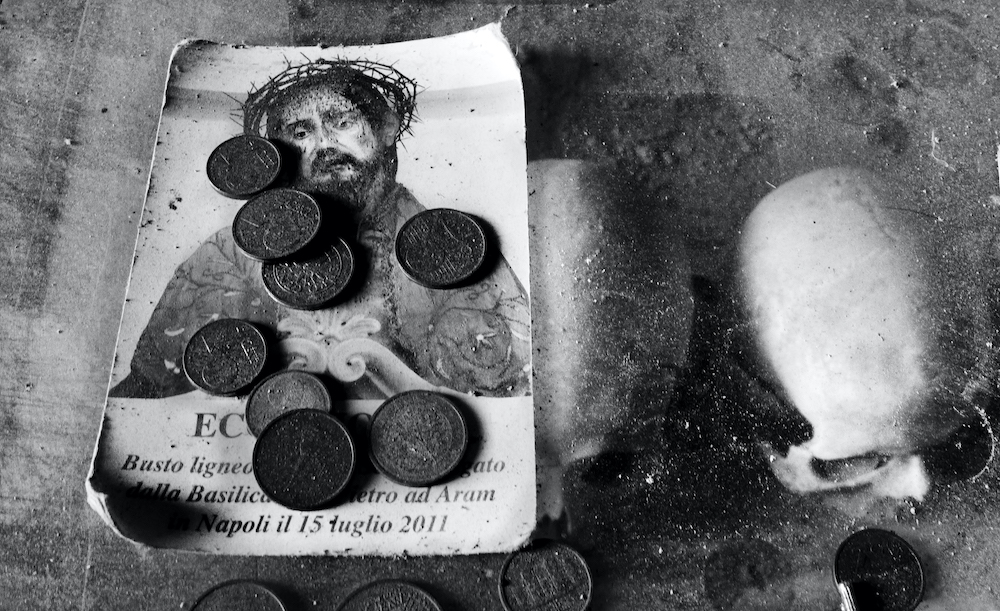If each city is like a game of chess, the day when I have learned the rules, I shall finally possess my empire, even if I shall never succeed in knowing all the cities it contains.
—Italo Calvino, Invisible Cities
Can you describe the mood of Naples as you feel/see it?
Living in Naples is like being enveloped in a thin fog that obscures your vision on a sunny day, or being betrayed by a mirage in a brief spell of rain, because nothing here is ever as it seems. If you have a strong heart, this city will break it; if you have a weak heart, this city will make it stronger. Just when you think you’ve understood it, or captured even the tiniest bit of its soul, you end up not comprehending a thing, because everything and the opposite of everything happens in Naples—reality melds with the imagination, producing a state of verisimilitude, of paradox. The body of this city is a continuous flux of matter and spirit, of sensuality and obscenity. This is a sorrowful city, made to desecrate and be desecrated, with a smile on its lips all the while. It’s a living contradiction, where otium becomes negotium and light lives alongside darkness, silence alongside noise, chaos alongside calm, beauty alongside deformity, joy alongside melancholy. It’s a city whose colors are showy yet at the same time leaden, it’s sophisticated yet ignorant, sacred yet profane, sweet yet violent. Here, Eros invariably comes hand in hand with Thanatos. And this city’s shoulders are broad enough to have given rise to countless clichés, glossy stereotypes created by and for its own self-interest. But there’s a special light here, not found anywhere else, born of the particular sea, history, and past of this city. And it has a voice that’s constantly whispering, like a lullaby.

Naples, 2016. Photo © Giampiero Assumma.
What is your most heartbreaking memory in this city?
This year’s COVID pandemic—the fear that broke this city’s soul and forced Neapolitans to stay cooped up at home. Even during World War II, Neapolitans didn’t abandon the streets of their city; they lived under bombardment from the Americans and forced the Germans to retreat. Neapolitans are descendants of the ancient Greeks, and they spend much of their lives out in the open air, inhabiting the agora, where everyone meets, converses, and exchanges ideas. Seeing the city’s deserted streets and squares was agonizing, because it was then that I grasped people’s fear through the sheer silence—the silence of the unknown.
What is the most extraordinary detail, one that goes unnoticed by most, of the city?
Its elegance. Naples is full of artisans who specialize in apparel. Tailor shops, shirt shops, cobblers, and historic shoemakers. Look into the closet of absolutely anyone in Naples, and you’ll find at least one tailor-made suit or dress. Neapolitan men are known all around the world for their elegance, but few realize that it comes primarily from the cut of their clothes as brought to life by their gait—it’s one’s body language and refined gestures that truly make a suit unique.
What writers from here should we read?
Raffaele La Capria, Domenico Rea, Michele Prisco, Fabrizia Ramondino, and Anna Maria Ortese, who is Neapolitan by adoption.

Naples, 2016. Photo © Giampiero Assumma.
Is there a place here you return to often?
The historic city center, which was built atop a Greek settlement and circumscribed by two ancient decumani—the main east-west streets—interlaced by a dense network of labyrinthine lanes and alleys, an underbelly of narrow, dark streets winding into one another. It’s a procession of one noble palazzo after another, of churches with weathered domes and bell towers, of chapels and catacombs, a hodgepodge of different styles and eras, often connected by underground or elevated passageways. Which is yet more proof of the fact that Neapolitans’ fates are tied up in the belief that sky and ground, heaven and earth, are each elements of a circular trajectory, a kind of to and fro that leads from life to death and vice versa.
Is there an iconic literary place we should know?
The Trentaremi promontory in Posillipo, a bay whose waters carried the ships of Aeneas and Ulysses. From the top you can see out across the bay, the islands, and the open sea. And if you stare at the horizon you can picture not just the ships of Aeneas and Ulysses appearing, but also the bows of ancient Greek, Roman, and Phoenician triremes, Arab vessels, and English, French, and Spanish galleys. An entire universe chose to moor in this sea.

Naples, 2016. Photo © Giampiero Assumma.
Are there hidden cities within this city that have intrigued or seduced you?
Naples is the city of a hundred cities, of a hundred satellites all orbiting the unique, massive planet that is memory. Every neighborhood is its own different town, its own country, with its own language, history, and character. Going from one part of town to the other means journeying with the feeling that you’re discovering an unbelievably diverse notion of humanity made up of various stories, memories, and dreams. The historic city center, the hillside cities like Vomero and Posillipo, and the seaside cities like Rione Sanità and Borgo dei Vergini.
Where does passion live here?
The most rational pursuit to devote oneself to in Naples is passion. Everything in Naples is exaggerated, and exaggeration is precisely the realm wherein the greatest passions are grown. You feel them in the air, in the streets, in the alleyways, in the homes, in the songs, in the art, in the literature, and in the human relationships of this city. The only passion that nobody cultivates in Naples is that of indifference.

Naples, 2013. Photo © Giampiero Assumma.
What is the title of one of your works about Naples and what inspired it exactly?
My latest novel, forthcoming next year, is titled A Romantic Agony, and it tells the story of a love affair between Andrea Fényes, a renowned professor and art collector, and Kim Burnett, an American director visiting Naples to make a film about the Neapolitan Revolution of 1799. It also involves the love triangle between William Hamilton, Horatio Nelson, and Amy Lyon (aka Emma, Lady Hamilton), an encounter in which alternating opposites—be they real or imagined—vie for possession of a hard-to-reach truth: Europe and America, man and woman, Andrea’s classicism and Kim’s modernity, Romantic painting and contemporary art, classical music and rock, light and shadow, good and evil, slowness and speed, cynicism and compassion.
Inspired by Levi, “Outside Naples does an outside exist?”
Naples is a unique city. It isn’t Italy. It’s part Europe, part Middle East, part America. If you’re born and raised in Naples, everything you need is here, and you could live here until the day you die. At the same time, it trains you to look beyond it, to countless other cultures and worlds. If you choose to go elsewhere, it opens the doors for you and wistfully lets you go, but it also reminds you that while fleeing the nest is a need, returning to one’s roots is a right. It is in Neapolitans’ nature to live like “souls who are suspended.”
Angelo Cannavacciuolo was born in Naples in 1956. He studied literature at the Instituto Orientale di Napoli. He has written, directed, and performed for cinema, theater, and television. His first novel, Guardiani delle nuvole, was a Viareggio Prize and Berto Prize Finalist, and winner of the Italian Readers Abroad Award at the Festival du Premier Roman de Chambéry. The film with the same name was winner of the Golden Pyramid at the Cairo International Festival. His second novel, Il soffio delle fate, was an Elsa Morante Prize Finalist, and Cannavacciuolo himself wrote the libretto of an opera with the same name. The opera premiered at the National Theater of Ostrava in the Czech Republic in May 2009. His third novel, Acque basse, garnered considerable critical acclaim. His piece Oratorio di Speranza, about the Israeli-Palestinian conflict, was staged at the Mediterranean Theater of Naples and at the prestigious Stransuld e Greinfeld Theater. His fourth novel, Le cose accadono, was the winner of the Viadana Prize and the Domenico Rea Prize. In 2018, he published Sacramerica for Ad Est Dell’Equatore, which was the winner of the Premio Letterario Letizia Isaia 2019. He was awarded the Premio Archita all’Istituto Italiano di Studi Filosofici for his body of work. A new novel, Una romantica agonia, will be published in 2021.
Alta L. Price runs a publishing consultancy specialized in literature and nonfiction texts on art, architecture, design, and culture. A recipient of the Gutekunst Prize, she translates from Italian and German into English. Her work has appeared on BBC Radio 4, 3 Quarks Daily, Specimen, and elsewhere. Her latest publications include books by Martin Mosebach, Dana Grigorcea, Anna Goldenberg, Alexander Kluge, and Aldo Novarese.
Giampiero Assumma is a photographer and videographer born in Naples in 1969. His work explores the human condition, borders, alienation, faith, addictions, and rituals. He has lived in various cities, and is currently based in Moscow. Visit his website or find him on Instagram.
© 2020 Angelo Cannavacciuolo. Translation © 2020 Alta L. Price.
Related Reading:
The City and the Writer: In Athens with Amanda Michalopoulou
Women in Translation: A Conversation with Margaret Carson and Alta L. Price
Living in a Sci-Fi Movie: An Italian Screenwriter on Coronavirus












